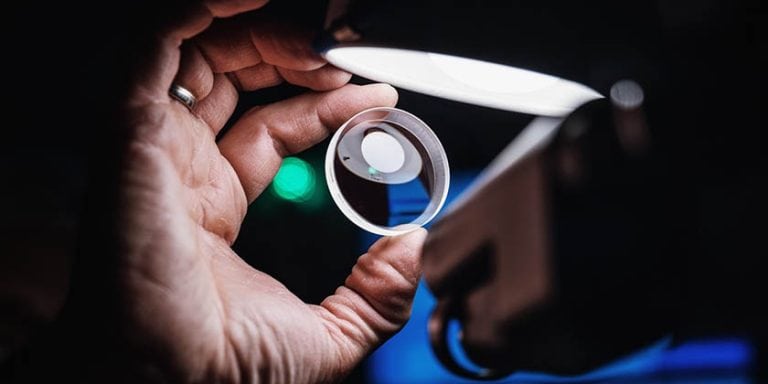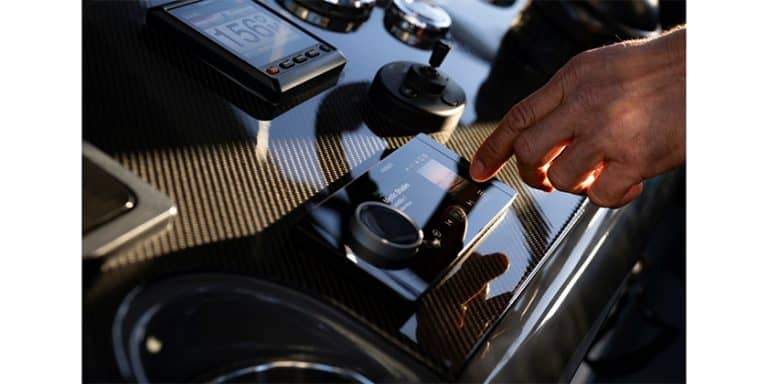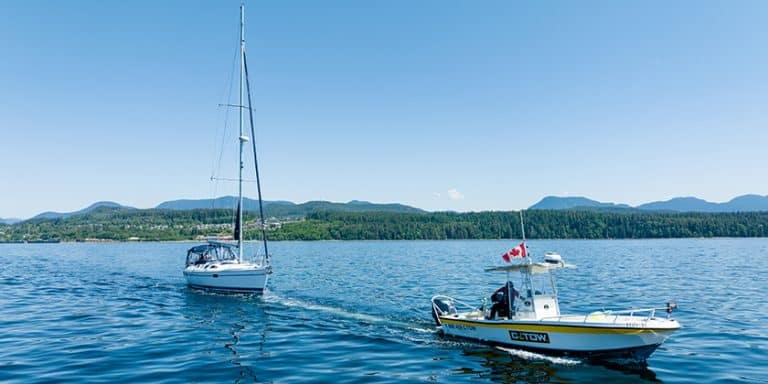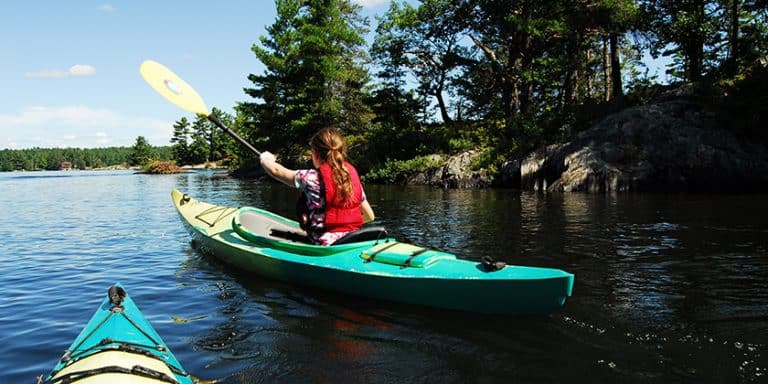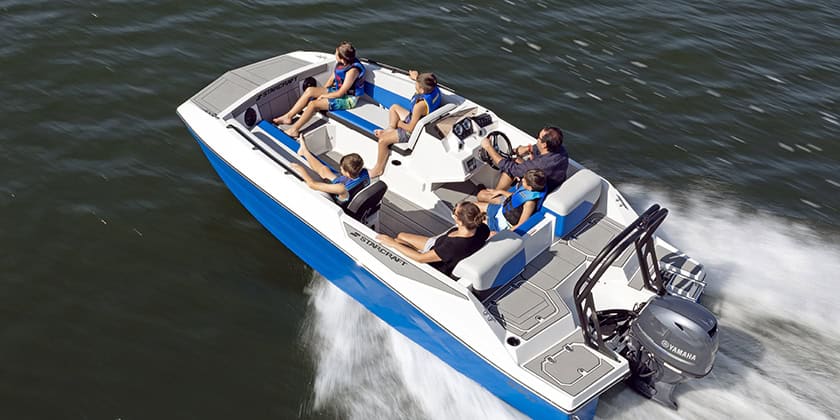Pinging the Unknown
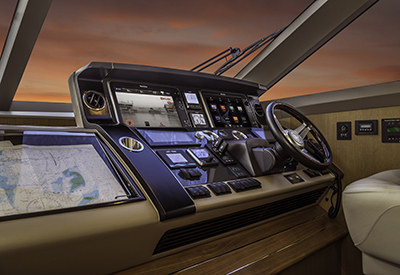
By David Schmidt
A look at the technologies that support modern marine radar
Sunshine flooded the waters separating California’s Catalina Island from Channel Islands Harbor, and Capt. Tom Petersen, skipper of the well-equipped Sea Ray 55 Sundancer Valkyrie, was leading a small flotilla when an unexpected fog bank quashed visibility. While Valkyrie carries the latest Raymarine kit (Petersen is a Raymarine Pro Ambassador), including a 12 kW, six-foot, open-array high-definition radar, Petersen’s companions weren’t electronically fortified.
“I sat behind the other boats, watching them on my radar and maintaining radio contact,” said Petersen. One boat didn’t have radar or autopilot, and the skipper was ignoring his compass. “I told him to keep [maintaining] a certain angle, but he picked up speed and went in the wrong direction. Then, he got scared.”
Staying calm, Petersen advised the panicked skipper to cut his speed, and he expertly used his radar to wend Valkyrie alongside. “Without radar this would have been dangerous,” advised Petersen, who shepherded the fog-tossed vessel back to the flotilla. “Your eyes can only do so much in the fog.”
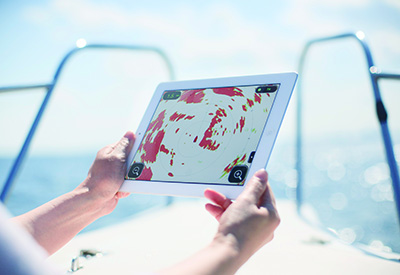 Raytheon delivered the world’s first commercial/recreational radar after WWII, and other systems followed, including now-generation systems that use high-definition (HD), broadband and Wi-Fi technologies to improve both radar imagery and the user interface. Still, these latest-and-greatest offerings use traditional radar technology as their basic foundation.
Raytheon delivered the world’s first commercial/recreational radar after WWII, and other systems followed, including now-generation systems that use high-definition (HD), broadband and Wi-Fi technologies to improve both radar imagery and the user interface. Still, these latest-and-greatest offerings use traditional radar technology as their basic foundation.
Traditional or “pulse-modulated” radars emit extremely short (typically, one microsecond or less) pulses of radio-frequency (RF) energy that are generated by the system’s magnetron and transmitted via a fixed-mount, rotating directional antenna. These pulses move at the speed of light in a narrow, horizontal band before bouncing off targets and boomeranging as an echo. Once received, the radar determines the range to a target by precisely measuring the elapsed time between a transmission and an echo’s return; bearing is calculated by measuring the radar antenna’s angle when the echo is received. Finally, the system applies filters to sift-out signal noise (e.g. breaking waves or rain) before presenting this imagery on an electronic display.
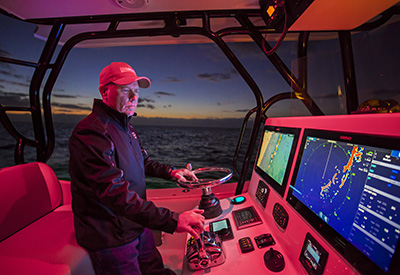 Pulse-modulated radars cannot simultaneously transmit and receive, so these systems (even modern ones) constantly cycle between modes. Typical pulse-modulated radars transmit some 400-4,000 times per second, and then spend the “majority” of their time “listening”, thus enabling the system to simultaneously track all targets within a 360-degree radius. Pulse-modulated radar can either be enclosed in a radome or it can use an open-array design; radome units typically draw 40-60 Watts while providing a maximum range of 24-36 miles (range is a function of transmitted power and antenna gain), while open-array systems typically draw 65-240 Watts and provide a maximum range of 64-96 nautical miles.
Pulse-modulated radars cannot simultaneously transmit and receive, so these systems (even modern ones) constantly cycle between modes. Typical pulse-modulated radars transmit some 400-4,000 times per second, and then spend the “majority” of their time “listening”, thus enabling the system to simultaneously track all targets within a 360-degree radius. Pulse-modulated radar can either be enclosed in a radome or it can use an open-array design; radome units typically draw 40-60 Watts while providing a maximum range of 24-36 miles (range is a function of transmitted power and antenna gain), while open-array systems typically draw 65-240 Watts and provide a maximum range of 64-96 nautical miles.
Pulse-modulated radar technology clearly works, although it can be difficult to separate and identify densely packed targets. Because of this, manufacturers employ a variety of now-generation technologies—including HD and broadband—to significantly improve radar imagery, but it’s still important to remember that all radar technology suffers attenuation issues in rain.
While the basic physics are the same between pulse-modulated and HD systems, today’s manufacturers use state-of-the-art technology to narrow the pulse’s horizontal band. Additionally, HD radar employs significantly faster sampling rates, while offering a color-coding scheme to bolster target separation. Other HD features include power boost; dual-radar support (allowing users to simultaneously run multiple radars), bird mode (great for fishing; see sidebar) and dual-range (provides both macro- and micro-level views of surrounding traffic), as well as sophisticated microprocessors that replace analog filters, and which are pre-programed to “recognize” certain signal noises.
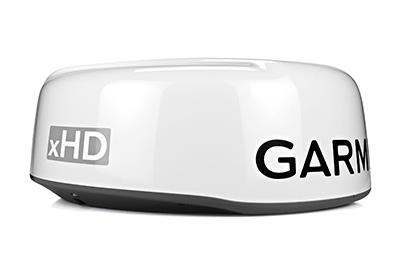 Unlike pulse-modulated radar, Broadband radar (including 3G and 4G offerings from B&G, Lowrance and Simrad) uses solid-state, continuous-wave technology that simultaneously transmits RF energy while receiving echoes. This technology transmits in a continuous linear sweep (think CHIRP sounder technology), which allows the system to extract the maximum amount of information with the minimum amount of noise. Broadband radar has no “main-bang” that’s inherent to all pulse-modulated radars, it emits less radiation than traditional radar, and it offers “instant-on” functionality, which eliminates the magnetron’s warm-up time. Additionally, 4G broadband radar has beam-sharpening technology with target-separation control that doubles the azimuth resolution, allowing an 18” dome to deliver imagery normally found in a three-foot open array radar.
Unlike pulse-modulated radar, Broadband radar (including 3G and 4G offerings from B&G, Lowrance and Simrad) uses solid-state, continuous-wave technology that simultaneously transmits RF energy while receiving echoes. This technology transmits in a continuous linear sweep (think CHIRP sounder technology), which allows the system to extract the maximum amount of information with the minimum amount of noise. Broadband radar has no “main-bang” that’s inherent to all pulse-modulated radars, it emits less radiation than traditional radar, and it offers “instant-on” functionality, which eliminates the magnetron’s warm-up time. Additionally, 4G broadband radar has beam-sharpening technology with target-separation control that doubles the azimuth resolution, allowing an 18” dome to deliver imagery normally found in a three-foot open array radar.
The latest chapter in radar technology involves wireless units, such as Furuno’s revolutionary, Wi-Fi-based DRS4W 1st Watch Wireless Radar, which debuted last fall. This radar, which offers a range of 0.125-24 nautical miles, is a small, lightweight system that offers several advantages while affording a glimpse at radar’s future. Aside from a power cable, the DRS4W operates sans hardwired connections, simplifying installation. More importantly, however, the DRS4W streams its data over the vessel’s Wi-Fi network and displays its imagery on up to two Apple iOS devices, eliminating the need for an expensive radar display and allowing boaters to use familiar touchscreen gestures, rather than memorizing the nuisances of a dedicated screen.
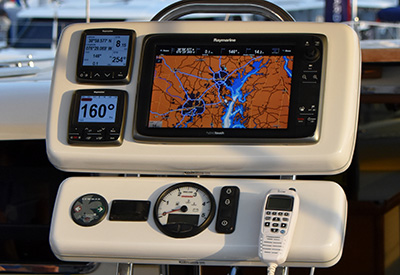 “In the past, you’ve had to have a radar antenna with a large, bulky signal cable coming into and connecting with the proprietary display,” explained Dean Kurutz, vice president of sales, marketing and product planning at Furuno. “Now, we’ve removed both, and we allow you to wirelessly transmit the radar signal to the iOS devise.” While the DRS4W was primarily designed for smaller boats, a larger yacht can run a DRS4W as a back-up unit; additionally, says Kurutz, a DRS4W can be set-up on a tender.
“In the past, you’ve had to have a radar antenna with a large, bulky signal cable coming into and connecting with the proprietary display,” explained Dean Kurutz, vice president of sales, marketing and product planning at Furuno. “Now, we’ve removed both, and we allow you to wirelessly transmit the radar signal to the iOS devise.” While the DRS4W was primarily designed for smaller boats, a larger yacht can run a DRS4W as a back-up unit; additionally, says Kurutz, a DRS4W can be set-up on a tender.
Furuno is the only manufacturer to offer Wi-Fi radar (at the time of this writing), but other brands are expected to join this market, and bigger, more powerful Wi-Fi radar systems are anticipated. This will hopefully lower radar’s barrier of entry, but here the last word belongs to Capt. Petersen: “If you had the choice to buy any one piece of electronics for your boat, get radar. If money and space aren’t an issue, [a] bigger, [more powerful system] really is better.”
Mastering Your Radar
Radar is a powerful navigational tool, but only if it’s properly set-up. According to Capt. Mark DeBlasio, the owner of Canyon Runner Sport Fishing, the key is to set-up your radar on a clear, sunny day (read: ample learning time) to ensure confidence come darkness/fog. Start by checking the radar’s alignment by heading out of the harbor, finding a buoy and aiming your bow directly at it. If it’s properly lined-up onscreen, the system is aligned.
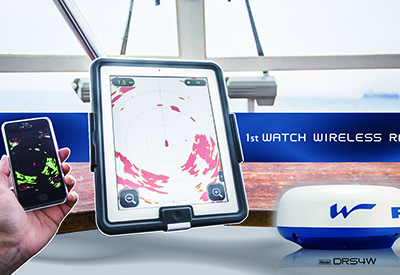 Next, DeBlasio recommends turning off all range rings and maintaining a clear screen, which makes it easier to see small boats and buoys. “Once I find a target, I set an electronic bearing line and a variable-range marker, which I monitor closely,” said DeBlasio, who sets his range at six miles for a single-range radar and at six/three miles (or less) for a dual-range radar.
Next, DeBlasio recommends turning off all range rings and maintaining a clear screen, which makes it easier to see small boats and buoys. “Once I find a target, I set an electronic bearing line and a variable-range marker, which I monitor closely,” said DeBlasio, who sets his range at six miles for a single-range radar and at six/three miles (or less) for a dual-range radar.
DeBlasio employs a similar methodology for finding flocks of birds, which are usually a harbinger for fish. Here, DeBlasio turns off all of his filters (i.e., rain and sea-clutter reduction) and increases his gain so that there’s some noise on his screen. “There’s noise, but there are clusters that are [denser],” said DeBlasio. “The [denser] noise is usually birds.”
Photo Captions
Photo 1 – Radar is one of the most important navigational tools on any helm or nav station. Credit: Raymarine
Photo 2 – Furuno’s new DRS4W 1st Watch Wireless Radar sends radar imagery to Apple wireless devices such as iPads and iPhones via the vessel’s Wi-Fi rout.
Photo 3 – Radar is particularly useful to navigators in fading light or in pitch blackness as it can provide increased situational awareness about other nearby vessels, land masses and even approaching weather cells. Credit: Simrad
Photo 4 – Traditional radar used pulse-modulated technology, but newer high-definition radars, such as this Garmin unit, use microprocessors instead of analog filters to “recognize” certain signal noises. Credit: Garmin
Photo 5 – Having a radar monitor at the helm can significantly reduce blood-pressure levels when negociating busy waters, fog, darkness or a narrow-beamed waterway. Credit: Greg Nicoll
Photo 6 – Furuno’s DRS4W 1st Watch Wireless Radar is the industry’s first wireless radar and is ideal for smaller boats, or as a back-up radar for bigger yachts. Credit: Furuno


